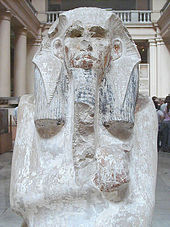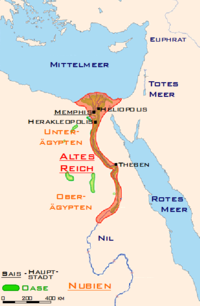Old Kingdom of Egypt
![]()
This article is about the Old Kingdom in Egypt. Old Kingdom is also a name for the Holy Roman Empire from the early modern period.
The Old Kingdom lasted from approximately 2700 to 2200 BC and is the oldest of the three classical periods of Ancient Egypt. It followed the Thinite period, which led to the formation of the Egyptian state, and spanned the 3rd to 6th Dynasties. The ensuing First Intermediate Period led to unstable political conditions in the country.
The Ancient Egyptians themselves regarded the era as the Golden Age and the high point of their culture. De facto, the period was characterized by extremely long-lasting political stability and the internal order of the country was not threatened by any external threats. The centralization of the state, which had already begun in the Thinite period, and the slowly emerging prosperity of the population led to remarkable architectural and artistic achievements. It came to the emergence of the first important genres of classical Egyptian literature, to the canonization of painting and sculpture, but also to numerous new introductions in the administration, which lasted almost three millennia.
The Old Kingdom is the age of the great pyramids, which were built in the area of the then capital Memphis: first the step pyramid of Pharaoh Djoser in Sakkara, then later the three monumental pyramids on the plateau of Giza (of Cheops, Chephren and Mykerinos), which are among the seven wonders of the ancient world. The pyramids impressively reflect the central position of the rulers in society and their power, which thereafter remained unrivalled in ancient Egyptian history. At the same time, they highlight the further development of the administrative apparatus and its ability to mobilize material and human resources. They also reveal the considerable progress made in architecture and art and reveal the central role played by the cult of the dead and belief in the afterlife at this time.
3rd dynasty
The 3rd Dynasty (2700 to 2620 BC) followed the Thinite period, which led to the unification of the empire and the formation of the first Egyptian state. The dynasty is commonly attributed to the Old Kingdom, as it marks the beginning of pyramid construction, which was crucial to this era. Some scholars prefer to place it in direct continuity with the 1st and 2nd Dynasties, which share many similarities in terms of political organization and cultural aspects. The transition from the 2nd to the 3rd Dynasty does not represent a real change of dynasty, since the first rulers of the 3rd Dynasty descended in a direct line from the royal house of the preceding dynasty.
There is some ambiguity about the number and sequence of the kings of the 3rd Dynasty. Problems are caused by the fact that the birth names, which have been handed down almost exclusively in later lists, can only rarely be brought into line with the contemporary Horus names. Of the five or six Horus names surviving from this period only Netjeri-chet can be clearly assigned to king Djoser. The order of the next three rulers Sechemchet, Chaba, and Sanacht, on the other hand, is uncertain. The presumably last ruler Huni was tentatively identified with the Horus name Qahedjet, but this assignment is not certain. The data for the duration of the 3rd Dynasty vary between 50 and 75 years.
King Djoser is considered the most important ruler of the 3rd Dynasty, as he had the first stepped pyramid and the first monumental stone building in the history of mankind created with his pyramid complex at Sakkara. The construction of the pyramid, which represents a pinnacle of early Egyptian stone construction, required enormous advances in logistical organization that could only be achieved through a well-functioning, tightly organized administration. Known as one of the most famous officials of this period, Imhotep served as advisor and master builder to Djoser and was revered and even deified as a legendary inventor well into the late period. Visible progress in the field of fine arts can best be seen in works from Djoser's reign, which clearly stand out from the preceding epoch in their execution.
The 3rd Dynasty was characterized by the strengthening of the central state, which was ruled from the new capital Memphis on the border between Upper and Lower Egypt. The high dignitaries were no longer buried in cemeteries in the province as in the early period, but were now given a place in the royal necropolis. The small pyramids erected in many places in the empire towards the end of the dynasty, on the other hand, underline the growing influence of the central government on the provinces. To procure building materials and other important raw materials, expeditions were sent to distant regions, such as Wadi Maghara in the west of the Sinai.

Statue of Djoser from Sakkara, Egyptian Museum Cairo.
5th dynasty
The rulers of the 5th Dynasty (2504 to 2347 BC) are known more precisely than those of the preceding dynasties, both through archaeological evidence and surviving texts. Their period is characterized by smaller pyramids, often located at Abusir, and temples to the sun god Re.
The kings (pharaohs) had to share their absolute power with the rising nobility and a growing bureaucracy. It is to the latter that we owe many of the preserved texts.
In the pyramid of Unas the so-called Pyramid Texts were found for the first time, which are thus the oldest surviving religious texts in human history. The tradition of placing afterlife literature in royal tombs was continued in the Middle Kingdom with the Coffin Texts and in the New Kingdom with the various Underworld Books (Amduat, Cave Book, Gate Book, etc.). In non-royal tombs of the New Kingdom papyri with the Book of the Dead were found.

Expansion of the Egyptian empire
Questions and Answers
Q: What is the Old Kingdom?
A: The Old Kingdom is the name for Egypt during the 3rd millennium BC when the civilization of Egypt had its first peak. It was the first of three so-called "Kingdom" periods, which mark the high points of civilization in the lower Nile Valley.
Q: How long did it last?
A: The Old Kingdom lasted from around 2686 BC to 2134 BC, spanning through Third Dynasty to Sixth Dynasty.
Q: Where was it located?
A: The Old Kingdom was located in Egypt, with Memphis as its royal capital.
Q: What are some features associated with this period?
A: During this period, great pyramids were built to be burial tombs for Pharaohs and a huge stone statue called Great Sphinx was created and placed nearby.
Q: Who built the Great Pyramid at Giza?
A: King Khufu (also known as Cheops) built the Great Pyramid at Giza near Cairo.
Q: How many blocks were used in building it?
A: The Great Pyramid was constructed using 2,300,000 blocks of limestone that weighed two and one-half tons apiece.
Q: How were people paid for their work on building it?
A: People who worked on constructing the Great Pyramid were paid with valuable things instead of coins since Egyptians had no coins yet.
Search within the encyclopedia